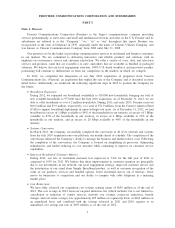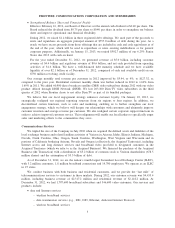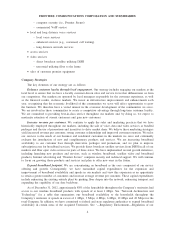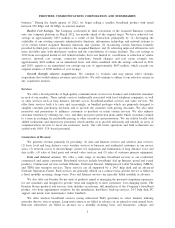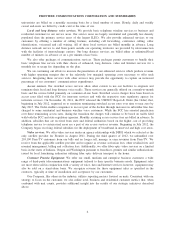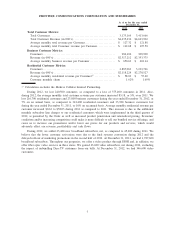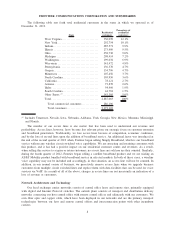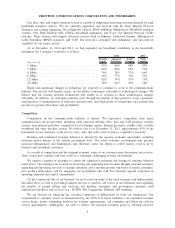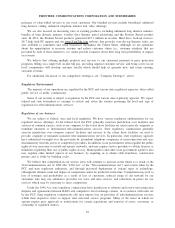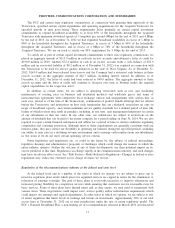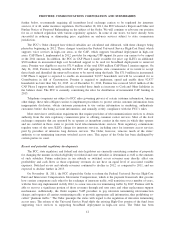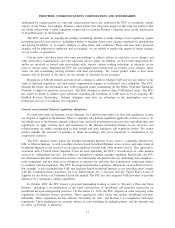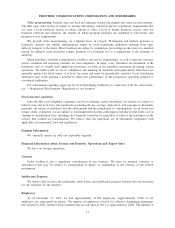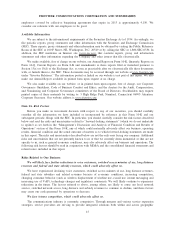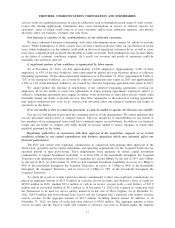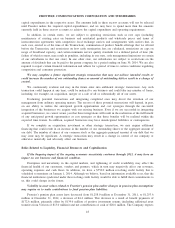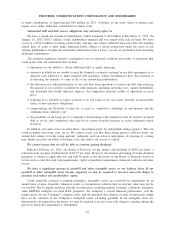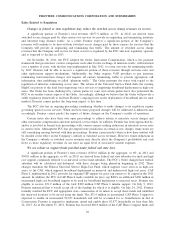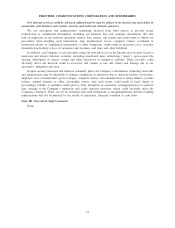Frontier Communications 2012 Annual Report Download - page 13
Download and view the complete annual report
Please find page 13 of the 2012 Frontier Communications annual report below. You can navigate through the pages in the report by either clicking on the pages listed below, or by using the keyword search tool below to find specific information within the annual report.further below, recommends requiring all incumbent local exchange carriers to be regulated for interstate
services, if at all, under incentive regulation. On November 18, 2011, the FCC released a Report and Order and
Further Notice of Proposed Rulemaking on the subject of the Order. We will continue to advocate our position
for no or reduced regulation with various regulatory agencies. In some of our states, we have already been
successful in reducing or eliminating price regulation on end-user services subject to state commission
jurisdiction.
The FCC’s Order changed how federal subsidies are calculated and disbursed, with these changes being
phased-in beginning in 2012. These changes transition the Federal Universal Service High-Cost Fund, which
supports voice services in high-cost areas, to the CAF, which supports broadband deployment in high-cost
areas. CAF Phase I, implemented in 2012, provides for ongoing USF support for price cap carriers to be capped
at the 2011 amount. In addition, the FCC in CAF Phase I made available for price cap ILECs an additional
$300 million in incremental high cost broadband support to be used for broadband deployment to unserved
areas. Frontier was eligible to receive $71.9 million of the total $300 million CAF Phase I interim support. On
July 24, 2012, Frontier formally notified the FCC and appropriate state commissions of its intent to accept
those funds and identified the unserved locations to be served using the funds. The $71.9 million in incremental
CAF Phase I support is expected to enable an incremental 92,877 households and will be accounted for as
Contributions in Aid of Construction. Frontier is required to implement, spend and enable these 92,877
households no later than July 24, 2015. As of December 31, 2012, Frontier has received $66.0 million of the
CAF Phase I support funds and has initially recorded these funds as increases to Cash and Other liabilities in
the balance sheet. The FCC is currently considering the rules for distribution of incremental CAF funding in
2013.
Telephone companies are subject to FCC rules governing privacy of certain customer information. Among
other things, these rules obligate carriers to implement procedures to: protect certain customer information from
inappropriate disclosure; obtain customer permission to use certain information in marketing; authenticate
customers before disclosing account information; and annually certify compliance with the FCC’s rules.
Most states have certification requirements that require providers of telecommunications services to obtain
authority from the state regulatory commission prior to offering common carrier services. Most of the local
exchange companies that are operated by us operate as incumbent carriers in the states in which they operate
and are certified in those states to provide local telecommunications services. State regulatory commissions
regulate some of the rates ILECs charge for intrastate services, including rates for intrastate access services
paid by providers of intrastate long distance services. The Order, however, removes much of the states’
authority to set terminating intrastate switched access rates. This aspect of the Order has been challenged by
certain parties in court.
Recent and potential regulatory developments
The FCC, state regulators, and federal and state legislators are currently considering a number of proposals
for changing the manner in which eligibility for federal and state subsidies is determined as well as the amounts
of such subsidies. Future reductions in our subsidy or switched access revenues may directly affect our
profitability and cash flows as those regulatory revenues do not have an equal level of associated variable
expenses. Switched access and subsidy revenues continued to decline in 2012, as compared to 2011, and are
expected to decline further in 2013.
On November 18, 2011, the FCC adopted the Order to reform the Federal Universal Service High-Cost
Fund and Intercarrier Compensation. Intercarrier Compensation, which is the payment framework that governs
how carriers compensate each other for the exchange of interstate traffic, will transition over a number of years,
with the first step implemented in July 2012, to a near zero rate for terminating traffic by 2017. Frontier will be
able to recover a significant portion of those revenues through end user rates and other replacement support
mechanisms. Additionally, the Order requires VoIP providers to pay interstate terminating interconnection
charges and requires all carriers terminating traffic to provide appropriate call information, thus prohibiting so-
called “phantom traffic.” The Order preempts the states with regard to the regulation of intrastate terminating
access rates. The reform of the Universal Service Fund shifts the existing High-Cost portion of the fund from
supporting voice services to supporting broadband deployment in high-cost areas. The Order has been
12
FRONTIER COMMUNICATIONS CORPORATION AND SUBSIDIARIES


